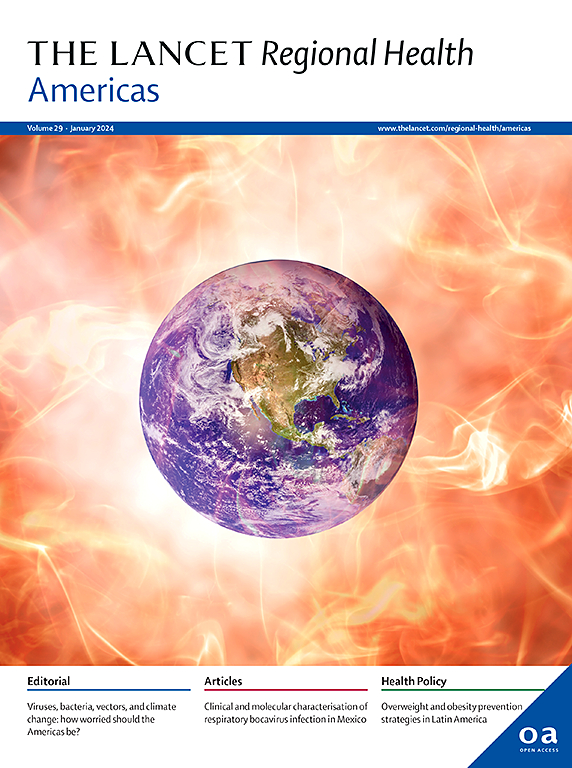巴西卡布罗博特鲁卡土著成年人慢性肾病的患病率和相关因素:一项基于人口的研究
IF 7
Q1 HEALTH CARE SCIENCES & SERVICES
引用次数: 0
摘要
背景由于生活方式的改变和非传染性疾病的增加等因素,慢性肾脏病(CKD)的发病率在全球范围内不断上升,尤其是在发展中国家。生活在社会经济条件较差地区的人群患慢性肾脏病的几率更高。这项横断面研究纳入了巴西卡布罗博的 1715 名特鲁卡土著成年人。根据肾病改善全球结果指南的分类,CKD 的定义为尿白蛋白/肌酐比值≥30 毫克/克和/或估计肾小球滤过率 <60 mL/min/1.73 m2。采用单变量和多元逻辑回归模型评估与 CKD 相关的因素。结果在分析的 1654 名参与者中(61 人因数据缺失而被排除),CKD 患病率为 10%(95% CI,8.6%-11.5%),女性患病率高于男性(12.4% 对 6.9%,p < 0.001)。平均年龄为 40.5 岁,女性占 55.6%。在单变量分析中,女性(OR,1.9;95% CI,1.3-2.7)、年龄≥60 岁(OR,4.6;95% CI,3.2-6.6)、心血管疾病(OR,2.1;95% CI,1.1-4.1)和血脂异常(OR,1.6;95% CI,1.1-2.4)被认为是与 CKD 相关的因素。多重逻辑回归分析表明,年龄≥60 岁、女性和血脂异常是导致慢性肾脏病的独立相关因素。我们的研究发现,尽管高血压、糖尿病、肥胖症的发病率很高,但它们与慢性肾脏病的风险之间没有关联。这些发现有助于在巴西原住民社区制定早期 CKD 检测策略,支持疾病治疗和预防。本文章由计算机程序翻译,如有差异,请以英文原文为准。
Prevalence and associated factors of chronic kidney disease among Truká Indigenous adults in Cabrobó, Brazil: a population-based study
Background
The prevalence of chronic kidney disease (CKD) is increasing worldwide, especially in developing countries, due to factors such as lifestyle changes and the rise of non-communicable diseases. Populations living in socioeconomically disadvantaged areas are subject to a higher burden of CKD. However, the burden of CKD on Brazilian Indigenous people, especially those undergoing an advanced urbanisation process, has not yet been described.
Methods
This cross-sectional study included 1715 Truká Indigenous adults from Cabrobó, Brazil. CKD was defined according to the Kidney Disease Improving Global Outcomes guidelines classification as a urinary albumin/creatinine ratio ≥30 mg/g and/or an estimated glomerular filtration rate <60 mL/min/1.73 m2. Univariate and multiple logistic regression models were used to evaluate factors associated with CKD. Odds ratio (OR) with a 95% confidence interval (CI) was used to measure association.
Findings
Out of the 1654 participants analysed (61 excluded due to missing data), the prevalence of CKD was 10% (95% CI, 8.6%–11.5%), with a higher prevalence in women compared to men (12.4% versus 6.9%, p < 0.001). The mean age was 40.5 years, with 55.6% being women. In univariate analysis, female sex (OR, 1.9; 95% CI, 1.3–2.7), age ≥60 years (OR, 4.6; 95% CI, 3.2–6.6), cardiovascular disease (OR, 2.1; 95% CI, 1.1–4.1), and dyslipidemia (OR, 1.6; 95% CI, 1.1–2.4) were identified as associated factors with CKD. Multiple logistic regression analysis identified age ≥60 years, female sex, and dyslipidemia as independently associated factors with CKD.
Interpretation
The prevalence of CKD among Truká Indigenous adults analysed is high and affects a higher proportion of women. Our study found no association between hypertension, diabetes, obesity, and CKD risk, despite their high prevalence. These findings assist in developing early CKD detection strategies in Brazilian Indigenous communities, supporting disease treatment and prevention.
Funding
National Council for Scientific and Technological Development (CNPq)–Ministry of Science, Technology, and Innovation of Brazil, and the Maria Emília Foundation.
求助全文
通过发布文献求助,成功后即可免费获取论文全文。
去求助
来源期刊

Lancet Regional Health-Americas
Multiple-
CiteScore
8.00
自引率
0.00%
发文量
0
期刊介绍:
The Lancet Regional Health – Americas, an open-access journal, contributes to The Lancet's global initiative by focusing on health-care quality and access in the Americas. It aims to advance clinical practice and health policy in the region, promoting better health outcomes. The journal publishes high-quality original research advocating change or shedding light on clinical practice and health policy. It welcomes submissions on various regional health topics, including infectious diseases, non-communicable diseases, child and adolescent health, maternal and reproductive health, emergency care, health policy, and health equity.
 求助内容:
求助内容: 应助结果提醒方式:
应助结果提醒方式:


